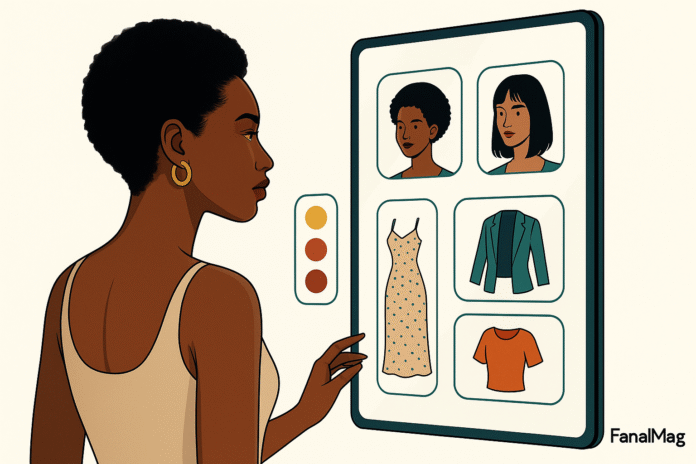Imagine trying on the perfect lipstick shade from your couch or seeing how a dress drapes on you—not a mannequin. Thanks to AI-powered virtual try-on technology, this is no longer a futuristic dream; it is becoming a mainstream reality—and it is happening fast.
From makeup counters to e-commerce apps, artificial intelligence (AI) and augmented reality (AR) are revolutionising how consumers discover, test, and buy beauty and fashion products. What started as a retail novelty has evolved into a multi-billion-dollar global market—and Africa is quietly positioning itself to ride the wave.
What is Happening Now
Virtual try-on tools, powered by AR and AI, allow shoppers to preview makeup, clothing, hairstyles, and accessories without touching a product. No messy testers, no guesswork—just instant visualisation.
These technologies have quickly gone from experimental to essential. In 2024, over 68% of beauty consumers worldwide reported using some form of AI-powered try-on tool before making a purchase. Beauty brands, retailers, and tech companies are racing to capture this growing demand.
Fast-Growing Market in Numbers
The numbers reveal a fast-evolving industry:
- Global Virtual Try-On Market: Valued at USD 9.17B in 2023, projected to reach USD 46.42B by 2030, at ~26.4% CAGR. (Grand View Research, 2024)
- Alternative Forecasts: Some reports project USD 12.5B in 2024, climbing to USD 48.8B by 2030 at *~25.5% CAGR. (Free Yourself, 2024)
- Beauty Tech Overall: The broader beauty tech market reached USD 66B in 2024, with AI and AR leading as the fastest-growing segments. (Grand View Research, 2024)
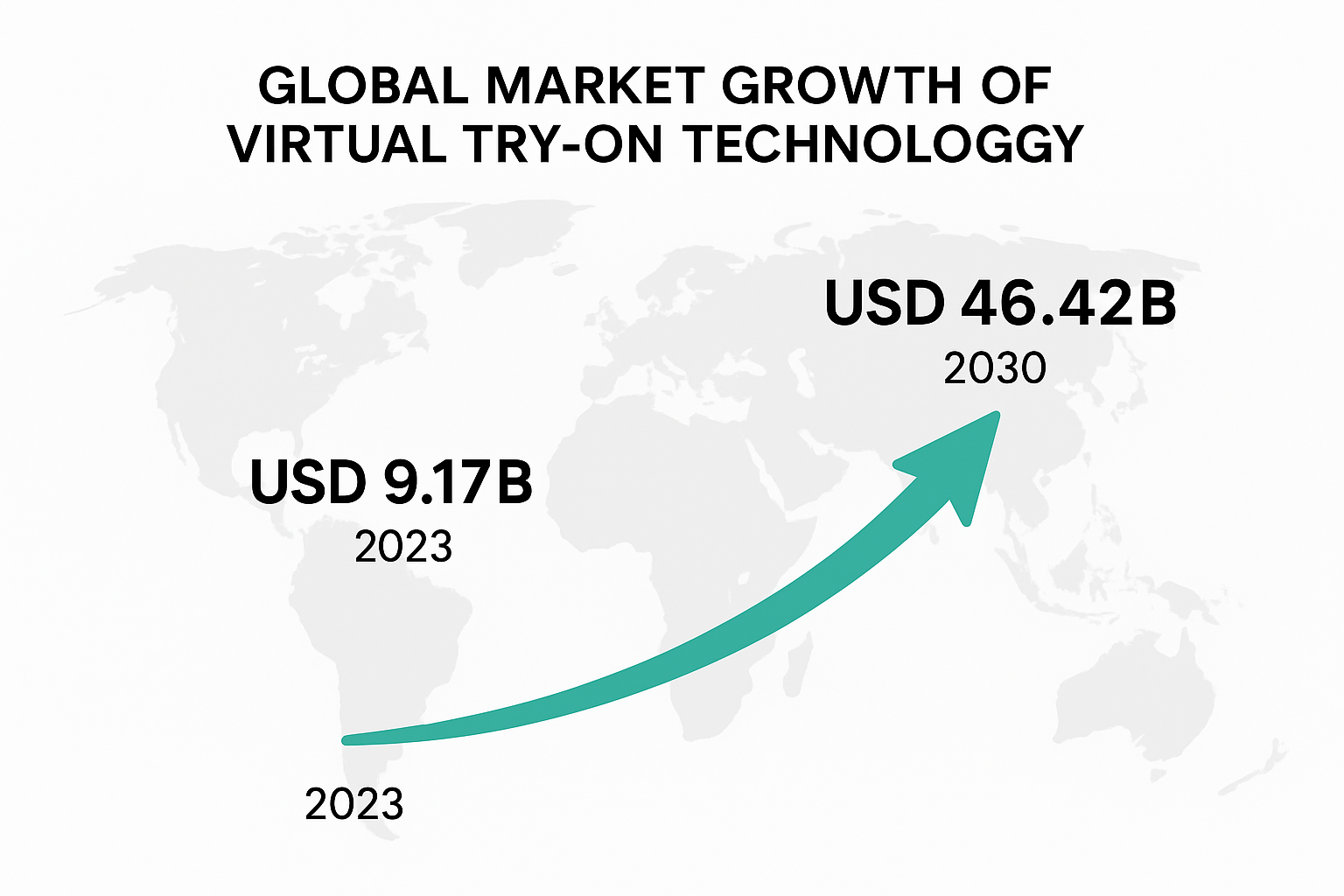
Africa’s Emerging Virtual Try-On Opportunity
While global markets lead adoption, Africa is on the brink of explosive growth:
- The Middle East & Africa (MEA) beauty tech market is projected to reach USD 5.66 billion by 2030, growing at a 14.9% CAGR. (Grand View Research, 2024)
- If virtual try-on captures even 20–30% of MEA’s beauty tech segment, Africa’s share could reach USD 0.5B–1.5B by 2030.
- Africa’s beauty and personal care market was worth USD 8.2 billion in 2023 and is expected to exceed USD 10 billion by 2025, driven by the growth of Nigeria, Kenya, and South Africa. (Vogue Business, 2024)
Why it matters: Mobile-first consumers, booming beauty culture, and WhatsApp-led shopping behaviours make Africa one of the most exciting emerging markets for AR-powered beauty tech.
Why Consumers Care
Virtual try-on tech is not a gimmick—it is redefining how people shop:
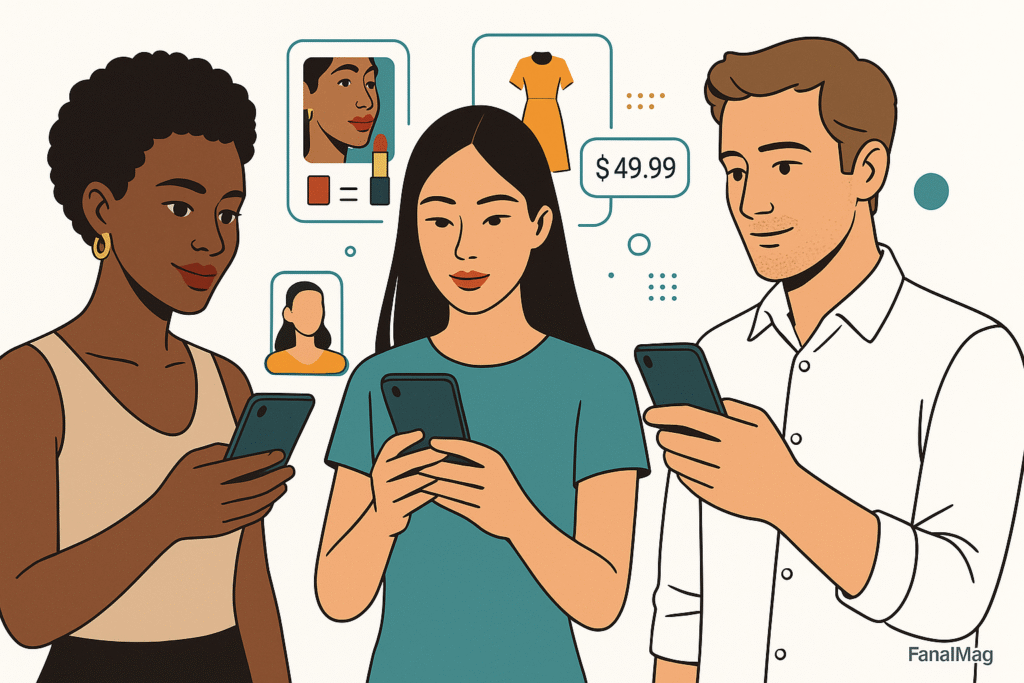
- Boosted Confidence → A Perfect Corp (2024) study found that virtual try-on doubles purchase likelihood and increases spending by 2.7×.
- Higher Conversions → According to Retail Dive, brands using AR see conversion rates rise 2.5× and product returns drop significantly.
- Better Margins → Forbes notes that virtual try-ons can increase sales by up to 30% and reduce returns by 20%, thereby improving retail profitability.
- Gen Z & Millennials Lead → Over 71% of Gen Z shoppers say they prefer brands offering AR-powered beauty previews. (McKinsey, 2024)
Where the Growth Is Coming From
Virtual try-on adoption is accelerating worldwide:
- Middle East & Africa (MEA) → 27% CAGR (2024–2030), fueled by e-commerce growth and mobile adoption.
- India → Over 30% CAGR, driven by smartphone penetration and local beauty e-commerce giants.
- China → Projected 26% CAGR, with Alibaba and Douyin leading the AR-commerce revolution.
- Europe & Japan → Growing steadily at 24–27% CAGR as luxury brands embrace AR-driven personalisation.
Tech in Action: Beauty & Fashion
As the numbers show, virtual try-on is not just about market size—it is transforming shopping experiences:
Beauty: Makeup, Hair & Skin
- Sally Beauty’s ColorView → lets users test hair colours virtually using Perfect Corp’s YouCam AI/AR engine. (Allure, 2024)
- AR “Magic Mirrors” → In-store kiosks let shoppers preview multiple shades without touching products—increasing hygiene and speed.
- Sephora & L’Oréal → Use personalised AI-driven beauty consultations to match foundations and skincare routines instantly.
Fashion: Clothes, Mirrors & Avatars
- Doji → AI-powered fashion app building personalised avatars so users can test designer outfits virtually; backed by Alexis Ohanian. (Business Insider, 2025)
- Google’s AI Try-On → Launched at I/O 2025, allows shoppers to upload personal photos and visualise clothes across 50B products. (Axios, 2025)
- AR Smart Mirrors → Emerging in malls, pop-ups, and transport hubs globally—and starting to appear in South Africa and Nigeria.
The Technologies Powering Virtual Try-On
Virtual try-on technology sits at the intersection of AI, AR, 3D visualisation, and e-commerce integration. These innovations work together to create seamless, hyper-personalised shopping experiences that are reshaping beauty and fashion retail globally.
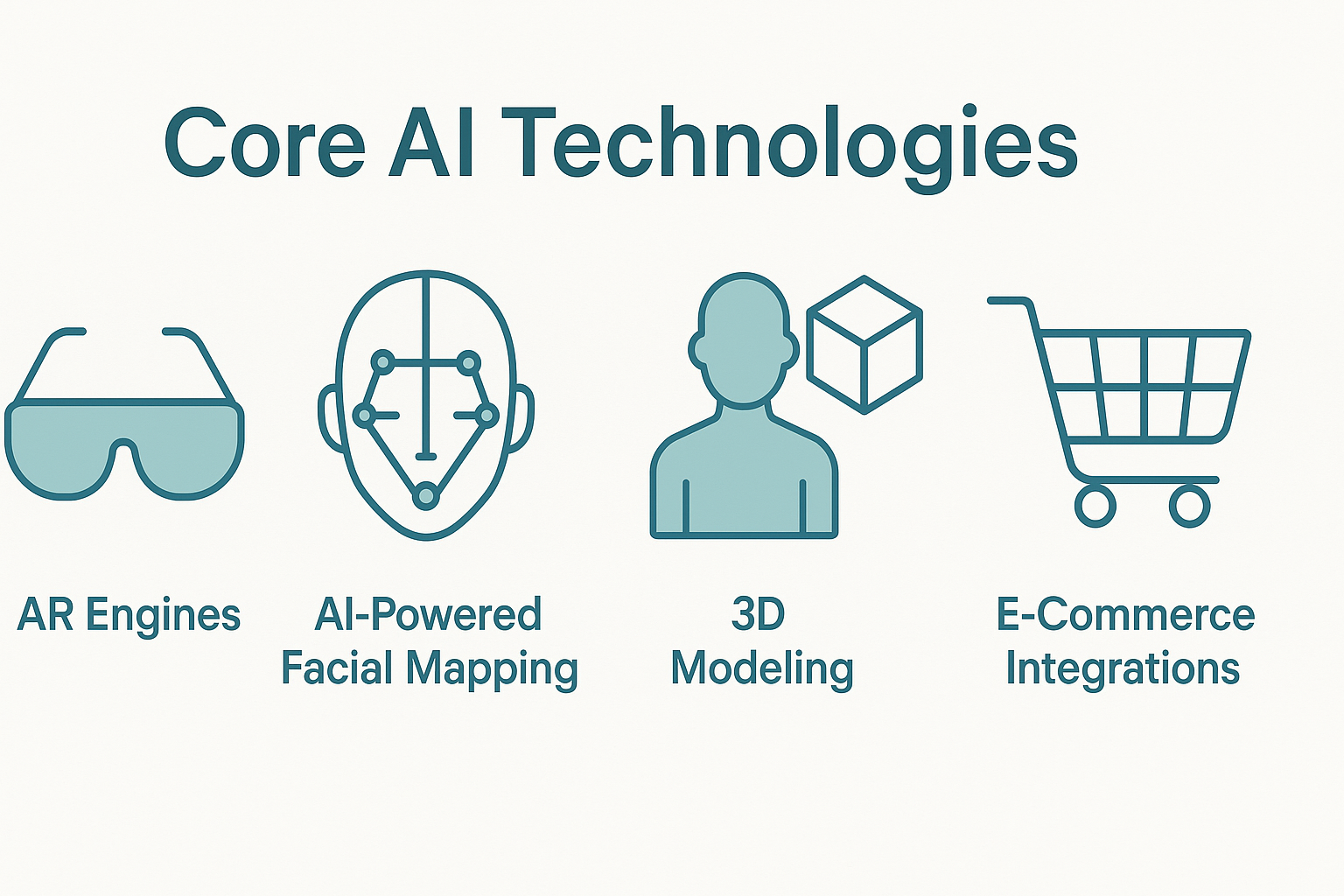
1. AR Engines: Bringing Products to Life
Platforms like Snap AR, Perfect Corp’s YouCam, and Banuba are leading the charge in real-time augmented reality (AR). These engines process live camera feeds and overlay digital products—such as lipsticks, hairstyles, dresses, and shoes—onto a user’s face or body.
- Snap AR powers Lenses for beauty brands, making AR try-ons accessible inside Snapchat and partner apps.
- Perfect Corp’s YouCam integrates directly into brand apps, such as Sally Beauty and Estée Lauder, allowing customers to virtually try thousands of makeup shades.
- Banuba, increasingly popular in emerging markets, focuses on lightweight AR SDKs optimised for low-end Android devices—a critical factor for African adoption.
2. AI-Powered Face & Skin Mapping
AR visuals are only as accurate as the AI behind them. Companies like ModiFace (acquired by L’Oréal) and Perfect Corp are pioneering AI-driven facial recognition and skin analysis.
- How it works: These models map 68+ facial landmarks, detect skin tone, undertones, and texture, and recommend personalised products.
- Why it matters: For African markets, AI models trained on diverse skin tones are essential to avoid mismatches—a problem that affects over 70% of existing global apps (Vogue Business, 2024).
3. 3D Modelling & Avatars: Trying On the Whole Outfit
Platforms like Vue.ai, Zakeke, and Doji create hyper-realistic 3D avatars that let shoppers visualise entire looks—not just individual products.
- Vue.ai enables retailers to generate personalised recommendations based on AI-analysed style preferences.
- Zakeke focuses on real-time 3D clothing previews, allowing customers to see exact fits and fabrics before making a purchase.
- Doji, a rising player, builds AI avatars from selfies, allowing shoppers to walk through virtual fashion showrooms. This is especially appealing to luxury fashion brands and African designers experimenting with Ankara prints and bespoke tailoring.
4. Social Commerce Integrations
E-commerce is no longer limited to websites—it is now native to social platforms.
- TikTok: AR-powered TikTok Shopping enables creators to showcase products with instant virtual try-ons, driving direct conversions from short-form videos.
- Instagram & Meta Shops: Meta integrates AR previews directly into Instagram and Facebook shopping journeys, making “tap-to-try” experiences mainstream.
- Shopify: The platform now offers plug-and-play AR try-on features, enabling small African beauty startups to compete globally without incurring massive R&D budgets.
5. Big Tech Plays: Google, Amazon, and Meta
The virtual try-on arms race is heating up, and tech giants are moving fast:
- Google launched its AI-powered Try-On feature at I/O 2025, allowing users to upload photos and visualise realistic clothing fits across more than 50 billion product listings (Axios, 2025).
- Amazon is expanding AR try-ons beyond makeup to include eyewear, shoes, and home decor, utilising real-time neural rendering for enhanced accuracy.
- Meta is embedding AR into WhatsApp Commerce—a massive opportunity for Africa, where WhatsApp dominates shopping journeys.
The Psychology Behind the Virtual Mirror
Virtual try-on does not just drive sales; it changes shopping behaviour:
- Try Before You Buy, Digitally → Over 71% of online shoppers want AR previews before purchasing.
- More Confidence, Fewer Returns → AR cuts uncertainty and reduces returns by up to 20%.
- The TikTok Effect → AR-powered beauty filters generate billions of impressions monthly, driving viral adoption.
- Personalisation Expectation → Consumers now expect AI-backed experiences that feel human and bespoke.
Challenges: When Tech Meets Reality
Despite its promise, virtual try-on faces four major hurdles:
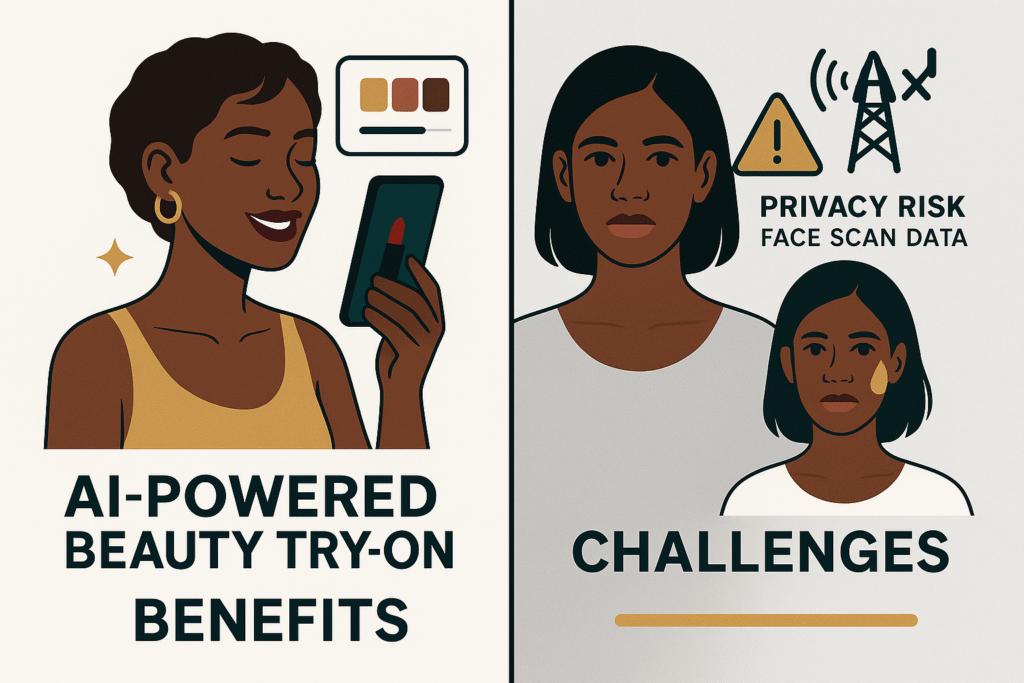
1. Algorithmic Bias
Over 70% of AR-powered beauty apps perform poorly on darker skin tones. (Vogue Business, 2024). AI doesn’t stop at cosmetics – it’s also reimagining skincare. Dive deeper into our AI Skincare Routines in 2025 article.
2. Privacy & Data Security
Virtual try-ons require facial scans—raising concerns over ownership, storage, and third-party sharing. Africa’s data laws lag, putting users at risk.
3. Accessibility & Infrastructure Gaps
High data costs, low-end devices, and weak broadband infrastructure limit adoption in emerging markets.
4. Cultural Fit & Representation
AI systems often “lighten” photos or ignore natural hairstyles like braids and locs. African-first brands have an opportunity to build inclusive datasets.
Why This Matters for Africa
If Africa wants to lead, rather than lag, in this space, representation, inclusivity, and trust must sit at the core of innovation. Building locally trained AI models, collaborating with African stylists and creators, and prioritising privacy-by-design will set homegrown solutions apart from imported ones.
- Build inclusive AI datasets reflecting African skin tones and hairstyles.
- Leverage WhatsApp commerce for AR try-on adoption.
- Partner with local creators and stylists to define authentic beauty standards.
This is not just participation—it is an opportunity for African brands to establish global standards.
Key Takeaways & What is Next
Virtual try-on technology is rewriting the rules of beauty and fashion—faster than you might think. It has been proven to deepen engagement, reduce returns, and increase accessibility. As markets reach hundreds of billions, inclusion and accuracy must rise in tandem with ambition.
- Virtual try-on is poised to explode: a USD 46B+ market by 2030.
- Consumers want personalisation and confidence in purchases.
- Africa is poised to leapfrog by combining mobile-first shopping, beauty culture, and AI.
- The winners will be brands that strike a balance between innovation, inclusivity, and trust.
As AI, AR, and e-commerce converge, virtual try-on is not just reshaping beauty—it’s redefining how we experience identity in a digital-first world.

